DIPL Audit Assurance: Financial Statement Analysis & Compliance
VerifiedAdded on 2020/02/24
|10
|1718
|44
Report
AI Summary
This report provides an audit assurance and compliance analysis of Double Ink Printers Limited (DIPL), an Australian printing company. It examines the company's financial statements, performs ratio analysis for the years 2013-2015, and identifies potential inherent risk factors. The analysis covers liquidity, profitability, capital structure, and efficiency ratios, revealing changes in the company's financial data and strategies. The report also discusses intentional misstatements and compliance with international and domestic reporting standards. Key fraud risk factors, such as changes in interest amounts and debt-to-equity ratios, are identified, emphasizing the auditors' responsibility to evaluate inaccuracies and potential fraud. The conclusion suggests that DIPL may have engaged in unethical activities and accounting irregularities to minimize tax liabilities and impress investors, leading to inherent risks.
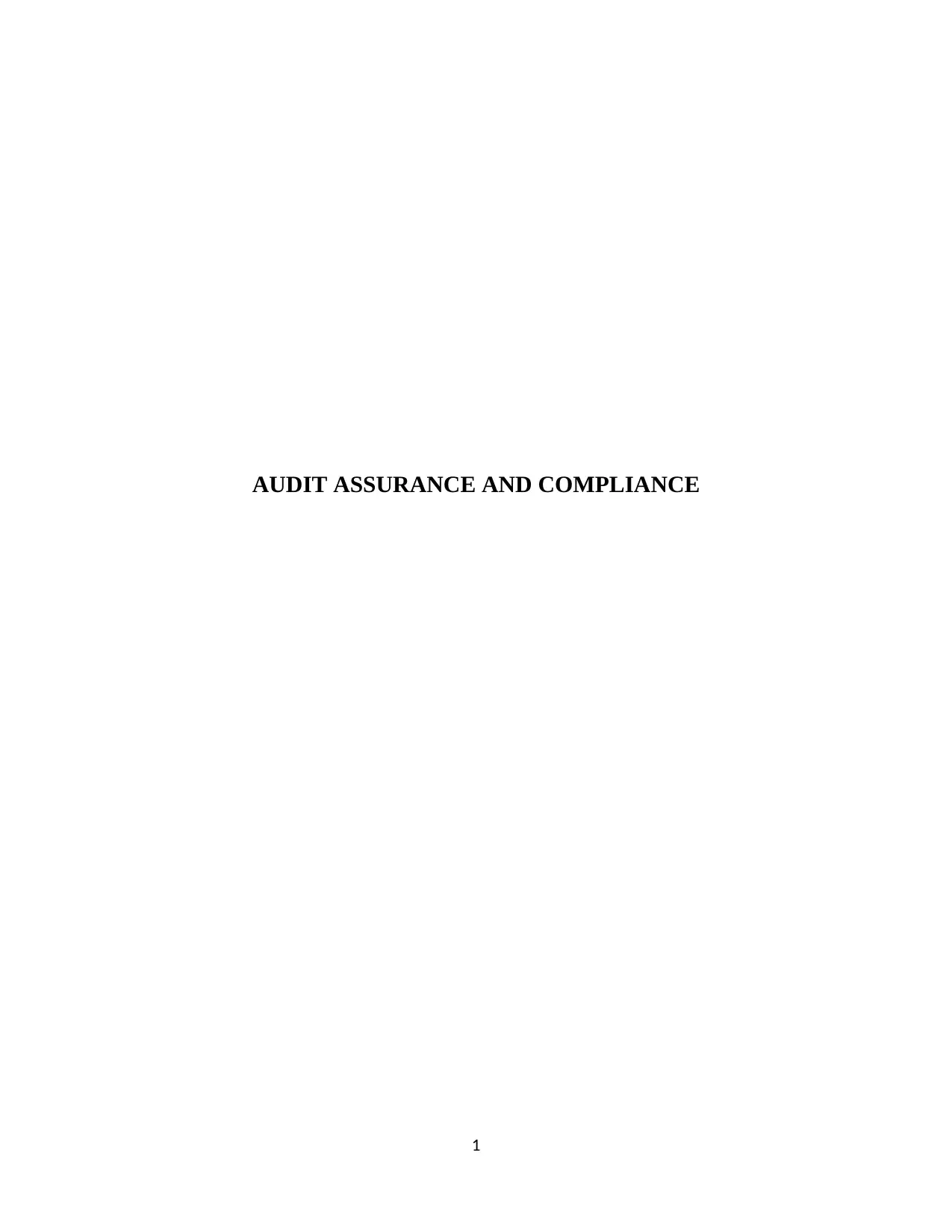
AUDIT ASSURANCE AND COMPLIANCE
1
1
Paraphrase This Document
Need a fresh take? Get an instant paraphrase of this document with our AI Paraphraser
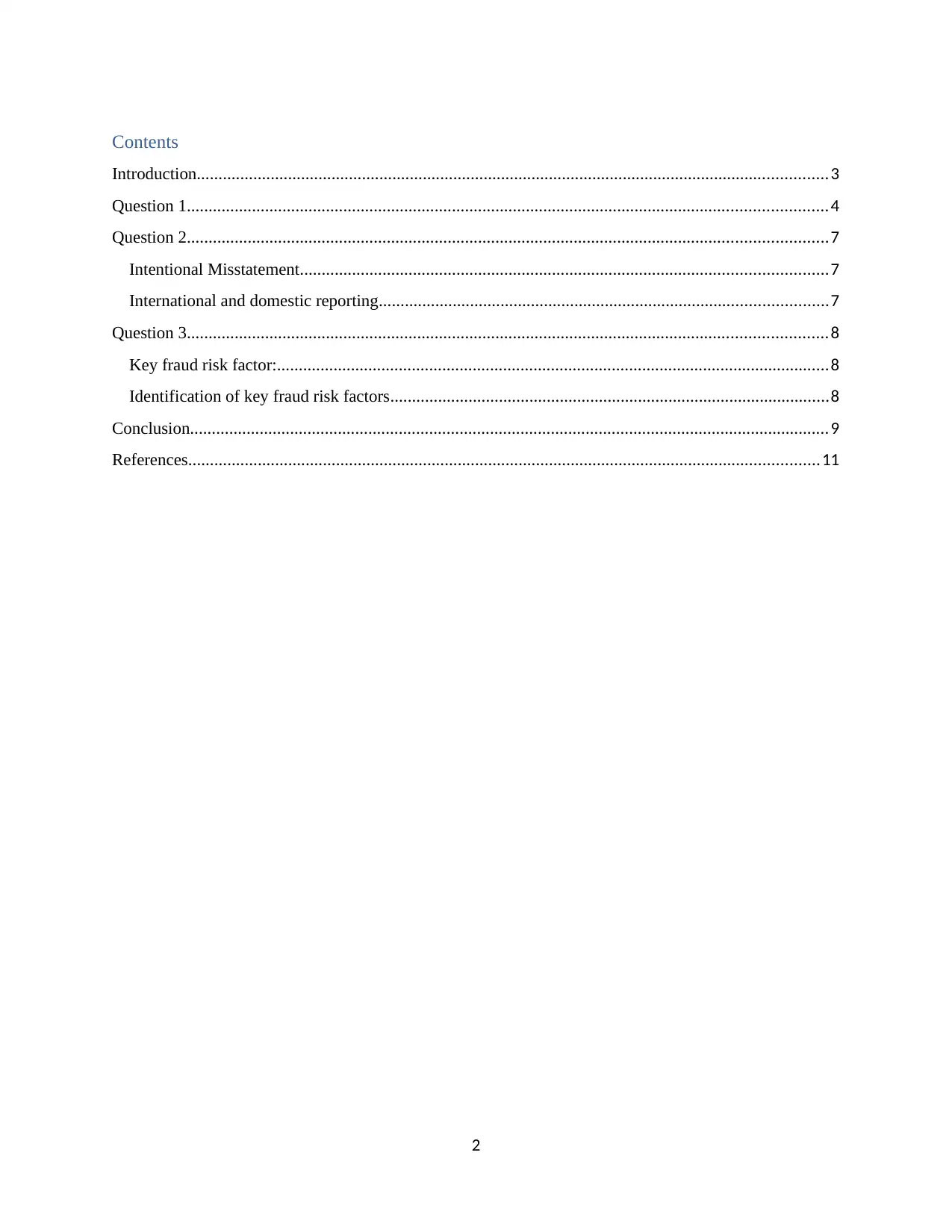
Contents
Introduction.................................................................................................................................................3
Question 1...................................................................................................................................................4
Question 2...................................................................................................................................................7
Intentional Misstatement.........................................................................................................................7
International and domestic reporting.......................................................................................................7
Question 3...................................................................................................................................................8
Key fraud risk factor:...............................................................................................................................8
Identification of key fraud risk factors.....................................................................................................8
Conclusion...................................................................................................................................................9
References.................................................................................................................................................11
2
Introduction.................................................................................................................................................3
Question 1...................................................................................................................................................4
Question 2...................................................................................................................................................7
Intentional Misstatement.........................................................................................................................7
International and domestic reporting.......................................................................................................7
Question 3...................................................................................................................................................8
Key fraud risk factor:...............................................................................................................................8
Identification of key fraud risk factors.....................................................................................................8
Conclusion...................................................................................................................................................9
References.................................................................................................................................................11
2

Introduction
In this study is done over DIPL which is an Australian based company. The business of the
company is printing. In this report financial statement of the company is been examined to
measure the ratios and to verify the reality of the statements. Inherent risk factors are also been
discussed in this report.
In this case study, we will examine the audit of the Double Ink Printers limited which is done by
Stewart and Kathy. The business of this company is to print the books, magazines, advertising
material for advertising etc. In addition to this examined of ratios has been done to measures the
performance of the company and to identify the financial condition of the company. Information
related to business helps in auditing process and to measure the business.
3
In this study is done over DIPL which is an Australian based company. The business of the
company is printing. In this report financial statement of the company is been examined to
measure the ratios and to verify the reality of the statements. Inherent risk factors are also been
discussed in this report.
In this case study, we will examine the audit of the Double Ink Printers limited which is done by
Stewart and Kathy. The business of this company is to print the books, magazines, advertising
material for advertising etc. In addition to this examined of ratios has been done to measures the
performance of the company and to identify the financial condition of the company. Information
related to business helps in auditing process and to measure the business.
3
⊘ This is a preview!⊘
Do you want full access?
Subscribe today to unlock all pages.

Trusted by 1+ million students worldwide
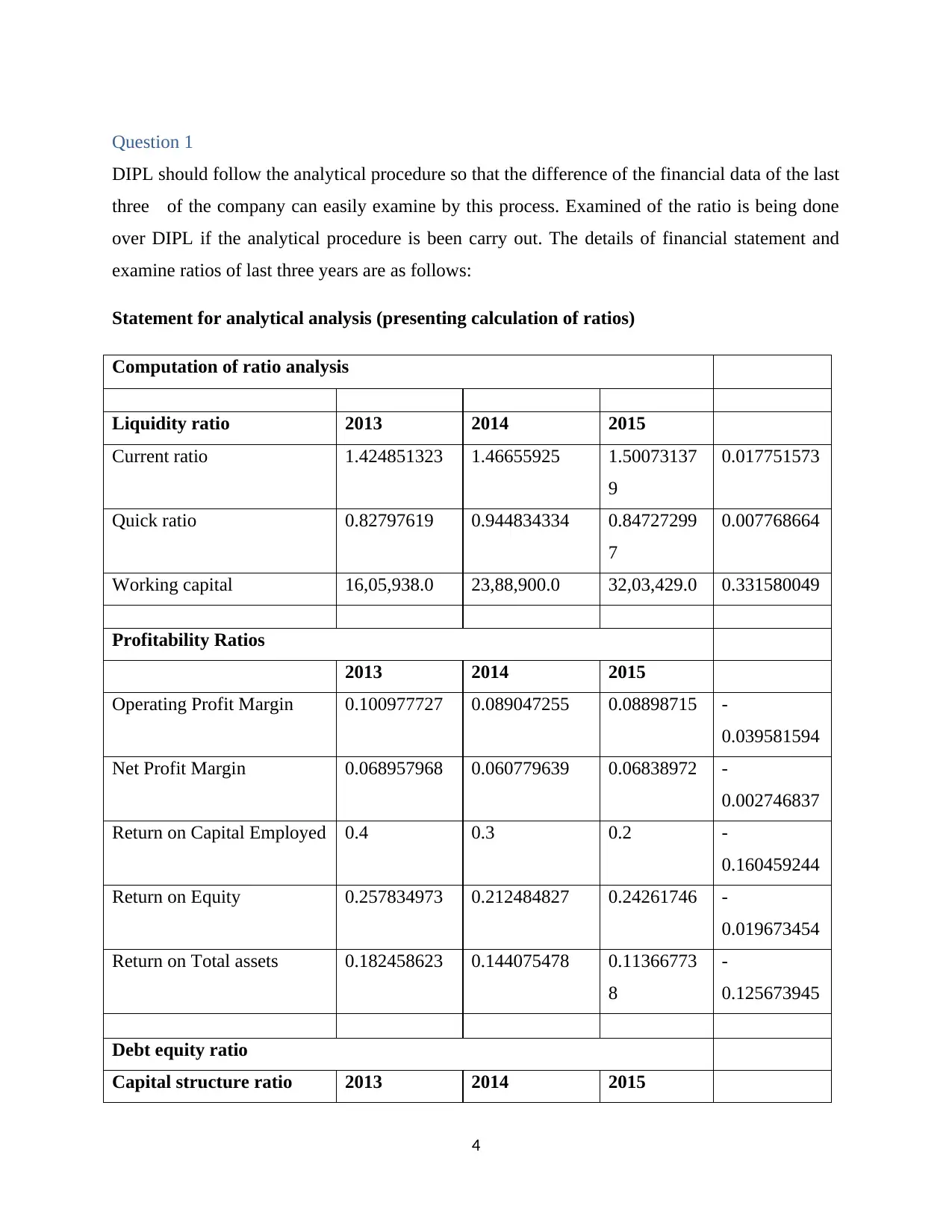
Question 1
DIPL should follow the analytical procedure so that the difference of the financial data of the last
three of the company can easily examine by this process. Examined of the ratio is being done
over DIPL if the analytical procedure is been carry out. The details of financial statement and
examine ratios of last three years are as follows:
Statement for analytical analysis (presenting calculation of ratios)
Computation of ratio analysis
Liquidity ratio 2013 2014 2015
Current ratio 1.424851323 1.46655925 1.50073137
9
0.017751573
Quick ratio 0.82797619 0.944834334 0.84727299
7
0.007768664
Working capital 16,05,938.0 23,88,900.0 32,03,429.0 0.331580049
Profitability Ratios
2013 2014 2015
Operating Profit Margin 0.100977727 0.089047255 0.08898715 -
0.039581594
Net Profit Margin 0.068957968 0.060779639 0.06838972 -
0.002746837
Return on Capital Employed 0.4 0.3 0.2 -
0.160459244
Return on Equity 0.257834973 0.212484827 0.24261746 -
0.019673454
Return on Total assets 0.182458623 0.144075478 0.11366773
8
-
0.125673945
Debt equity ratio
Capital structure ratio 2013 2014 2015
4
DIPL should follow the analytical procedure so that the difference of the financial data of the last
three of the company can easily examine by this process. Examined of the ratio is being done
over DIPL if the analytical procedure is been carry out. The details of financial statement and
examine ratios of last three years are as follows:
Statement for analytical analysis (presenting calculation of ratios)
Computation of ratio analysis
Liquidity ratio 2013 2014 2015
Current ratio 1.424851323 1.46655925 1.50073137
9
0.017751573
Quick ratio 0.82797619 0.944834334 0.84727299
7
0.007768664
Working capital 16,05,938.0 23,88,900.0 32,03,429.0 0.331580049
Profitability Ratios
2013 2014 2015
Operating Profit Margin 0.100977727 0.089047255 0.08898715 -
0.039581594
Net Profit Margin 0.068957968 0.060779639 0.06838972 -
0.002746837
Return on Capital Employed 0.4 0.3 0.2 -
0.160459244
Return on Equity 0.257834973 0.212484827 0.24261746 -
0.019673454
Return on Total assets 0.182458623 0.144075478 0.11366773
8
-
0.125673945
Debt equity ratio
Capital structure ratio 2013 2014 2015
4
Paraphrase This Document
Need a fresh take? Get an instant paraphrase of this document with our AI Paraphraser
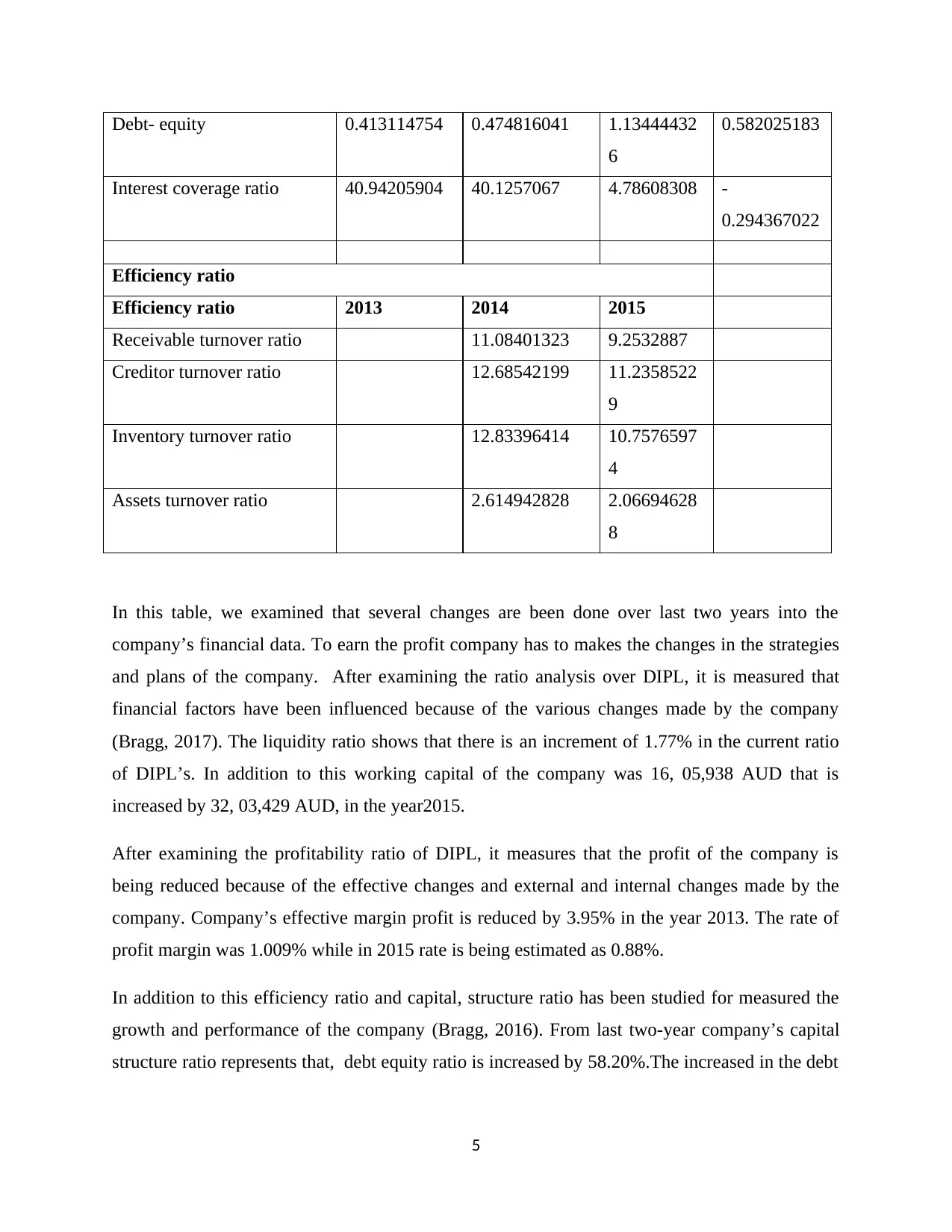
Debt- equity 0.413114754 0.474816041 1.13444432
6
0.582025183
Interest coverage ratio 40.94205904 40.1257067 4.78608308 -
0.294367022
Efficiency ratio
Efficiency ratio 2013 2014 2015
Receivable turnover ratio 11.08401323 9.2532887
Creditor turnover ratio 12.68542199 11.2358522
9
Inventory turnover ratio 12.83396414 10.7576597
4
Assets turnover ratio 2.614942828 2.06694628
8
In this table, we examined that several changes are been done over last two years into the
company’s financial data. To earn the profit company has to makes the changes in the strategies
and plans of the company. After examining the ratio analysis over DIPL, it is measured that
financial factors have been influenced because of the various changes made by the company
(Bragg, 2017). The liquidity ratio shows that there is an increment of 1.77% in the current ratio
of DIPL’s. In addition to this working capital of the company was 16, 05,938 AUD that is
increased by 32, 03,429 AUD, in the year2015.
After examining the profitability ratio of DIPL, it measures that the profit of the company is
being reduced because of the effective changes and external and internal changes made by the
company. Company’s effective margin profit is reduced by 3.95% in the year 2013. The rate of
profit margin was 1.009% while in 2015 rate is being estimated as 0.88%.
In addition to this efficiency ratio and capital, structure ratio has been studied for measured the
growth and performance of the company (Bragg, 2016). From last two-year company’s capital
structure ratio represents that, debt equity ratio is increased by 58.20%.The increased in the debt
5
6
0.582025183
Interest coverage ratio 40.94205904 40.1257067 4.78608308 -
0.294367022
Efficiency ratio
Efficiency ratio 2013 2014 2015
Receivable turnover ratio 11.08401323 9.2532887
Creditor turnover ratio 12.68542199 11.2358522
9
Inventory turnover ratio 12.83396414 10.7576597
4
Assets turnover ratio 2.614942828 2.06694628
8
In this table, we examined that several changes are been done over last two years into the
company’s financial data. To earn the profit company has to makes the changes in the strategies
and plans of the company. After examining the ratio analysis over DIPL, it is measured that
financial factors have been influenced because of the various changes made by the company
(Bragg, 2017). The liquidity ratio shows that there is an increment of 1.77% in the current ratio
of DIPL’s. In addition to this working capital of the company was 16, 05,938 AUD that is
increased by 32, 03,429 AUD, in the year2015.
After examining the profitability ratio of DIPL, it measures that the profit of the company is
being reduced because of the effective changes and external and internal changes made by the
company. Company’s effective margin profit is reduced by 3.95% in the year 2013. The rate of
profit margin was 1.009% while in 2015 rate is being estimated as 0.88%.
In addition to this efficiency ratio and capital, structure ratio has been studied for measured the
growth and performance of the company (Bragg, 2016). From last two-year company’s capital
structure ratio represents that, debt equity ratio is increased by 58.20%.The increased in the debt
5

equity ratio is because of due to variations in the company’s liabilities and assets in last two
years.
There is various ratios such as inventory turnover ratio, Assets turnover ratio, efficiency ratios,
the receivable turnover ratio of the company is being measured, so that company performance
can be measured in terms of the obligation and working capital.
In this report, it mentioned that because of the variations are done in the business’s plans and
strategies, operations, and functions, changes have been taking place ( Fazal, 2011). It has been a
difficult job for auditors to evaluate the changes and action occur in the business. It is a
responsibility of Stewart and Kathy to evaluate the inaccuracies and mistakes.
6
years.
There is various ratios such as inventory turnover ratio, Assets turnover ratio, efficiency ratios,
the receivable turnover ratio of the company is being measured, so that company performance
can be measured in terms of the obligation and working capital.
In this report, it mentioned that because of the variations are done in the business’s plans and
strategies, operations, and functions, changes have been taking place ( Fazal, 2011). It has been a
difficult job for auditors to evaluate the changes and action occur in the business. It is a
responsibility of Stewart and Kathy to evaluate the inaccuracies and mistakes.
6
⊘ This is a preview!⊘
Do you want full access?
Subscribe today to unlock all pages.

Trusted by 1+ million students worldwide

Question 2.
The new clients in DIPL are Stewart and Kathy’s, it is essential for auditors to follows the
DIPL’s risk assessment for examined the risk elements and make the decision to solve the out
risks. In this report risks factors play an important role are as follows:
Intentional Misstatement
Inherent risk can take place, when-
- The accountant prepares financial statement, without follows any guidelines
Or
- Frauds activities followed by the accountant for preparing the financial statement.
Examined the DIPL’s case study, there is an increment in the revenue in the last two years, due
to this company profit remain less. Because of this company have to pay the high tax return to
the Australian government in terms of higher profits (Bragg, 2016). As a result of this company
starts doing frauds activities in order to this reduce the profit margin so that company has to pay
the less tax and shown in the financial statements. In addition to this by showing the impressive
performance of the company in the financial statement, it also impresses the shareholders so that
they can invest more in the company ( Perler & Howard M. , 2010). As a result of this
misstatement in books of accounts are in the inherent risk factor for DIPL.
International and domestic reporting
In this case study, the business of company can easily manage at domestic level and operated by
individuals. But for the international level company have to follow the rules and principles of
IFRS and GAAP (Kimmel & Weygandt , 2013). After following the rules and principle of the
general accounting company can get the favor from FDIC for huge investment. It is necessary for
the company to follow the rules and principle for preparing the financial statement.
7
The new clients in DIPL are Stewart and Kathy’s, it is essential for auditors to follows the
DIPL’s risk assessment for examined the risk elements and make the decision to solve the out
risks. In this report risks factors play an important role are as follows:
Intentional Misstatement
Inherent risk can take place, when-
- The accountant prepares financial statement, without follows any guidelines
Or
- Frauds activities followed by the accountant for preparing the financial statement.
Examined the DIPL’s case study, there is an increment in the revenue in the last two years, due
to this company profit remain less. Because of this company have to pay the high tax return to
the Australian government in terms of higher profits (Bragg, 2016). As a result of this company
starts doing frauds activities in order to this reduce the profit margin so that company has to pay
the less tax and shown in the financial statements. In addition to this by showing the impressive
performance of the company in the financial statement, it also impresses the shareholders so that
they can invest more in the company ( Perler & Howard M. , 2010). As a result of this
misstatement in books of accounts are in the inherent risk factor for DIPL.
International and domestic reporting
In this case study, the business of company can easily manage at domestic level and operated by
individuals. But for the international level company have to follow the rules and principles of
IFRS and GAAP (Kimmel & Weygandt , 2013). After following the rules and principle of the
general accounting company can get the favor from FDIC for huge investment. It is necessary for
the company to follow the rules and principle for preparing the financial statement.
7
Paraphrase This Document
Need a fresh take? Get an instant paraphrase of this document with our AI Paraphraser
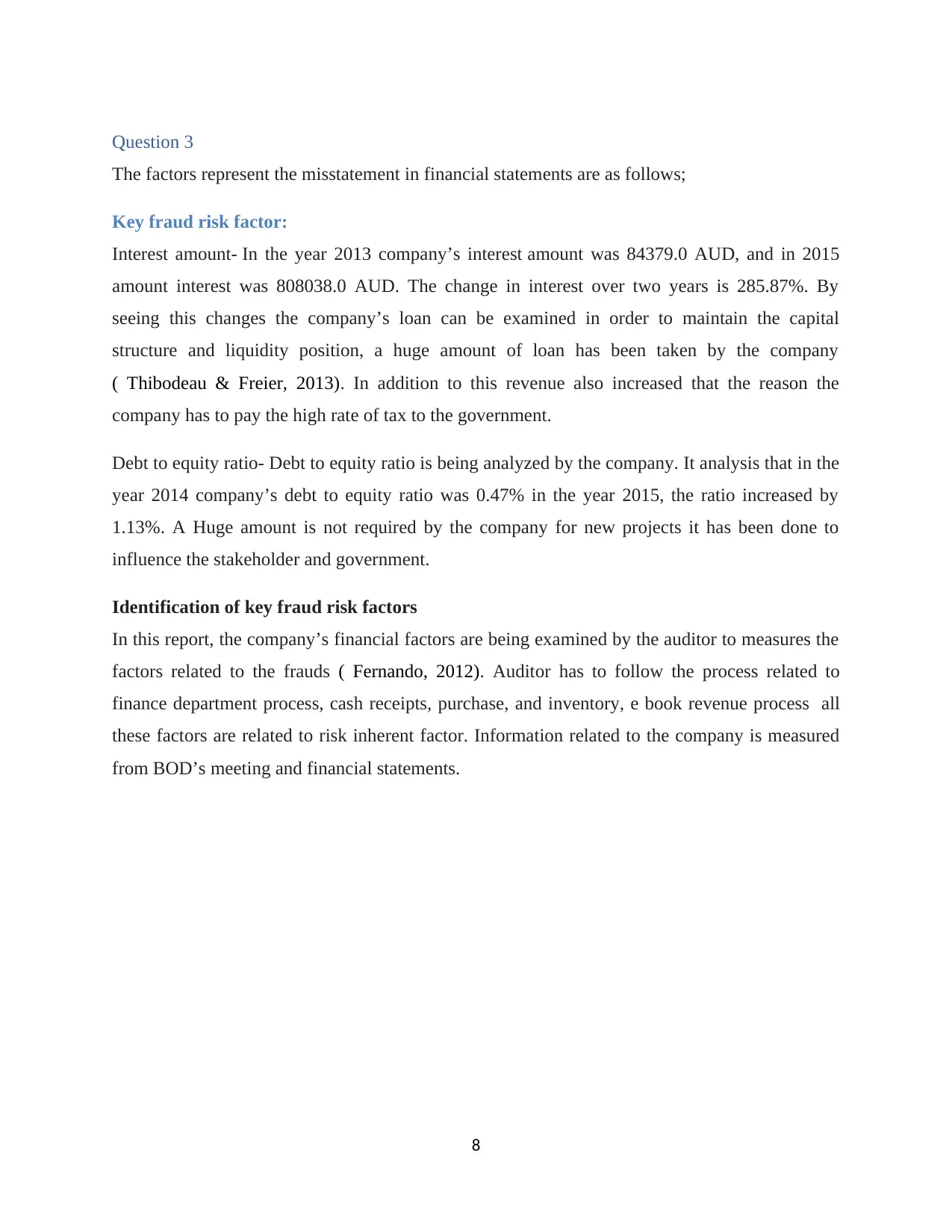
Question 3
The factors represent the misstatement in financial statements are as follows;
Key fraud risk factor:
Interest amount- In the year 2013 company’s interest amount was 84379.0 AUD, and in 2015
amount interest was 808038.0 AUD. The change in interest over two years is 285.87%. By
seeing this changes the company’s loan can be examined in order to maintain the capital
structure and liquidity position, a huge amount of loan has been taken by the company
( Thibodeau & Freier, 2013). In addition to this revenue also increased that the reason the
company has to pay the high rate of tax to the government.
Debt to equity ratio- Debt to equity ratio is being analyzed by the company. It analysis that in the
year 2014 company’s debt to equity ratio was 0.47% in the year 2015, the ratio increased by
1.13%. A Huge amount is not required by the company for new projects it has been done to
influence the stakeholder and government.
Identification of key fraud risk factors
In this report, the company’s financial factors are being examined by the auditor to measures the
factors related to the frauds ( Fernando, 2012). Auditor has to follow the process related to
finance department process, cash receipts, purchase, and inventory, e book revenue process all
these factors are related to risk inherent factor. Information related to the company is measured
from BOD’s meeting and financial statements.
8
The factors represent the misstatement in financial statements are as follows;
Key fraud risk factor:
Interest amount- In the year 2013 company’s interest amount was 84379.0 AUD, and in 2015
amount interest was 808038.0 AUD. The change in interest over two years is 285.87%. By
seeing this changes the company’s loan can be examined in order to maintain the capital
structure and liquidity position, a huge amount of loan has been taken by the company
( Thibodeau & Freier, 2013). In addition to this revenue also increased that the reason the
company has to pay the high rate of tax to the government.
Debt to equity ratio- Debt to equity ratio is being analyzed by the company. It analysis that in the
year 2014 company’s debt to equity ratio was 0.47% in the year 2015, the ratio increased by
1.13%. A Huge amount is not required by the company for new projects it has been done to
influence the stakeholder and government.
Identification of key fraud risk factors
In this report, the company’s financial factors are being examined by the auditor to measures the
factors related to the frauds ( Fernando, 2012). Auditor has to follow the process related to
finance department process, cash receipts, purchase, and inventory, e book revenue process all
these factors are related to risk inherent factor. Information related to the company is measured
from BOD’s meeting and financial statements.
8
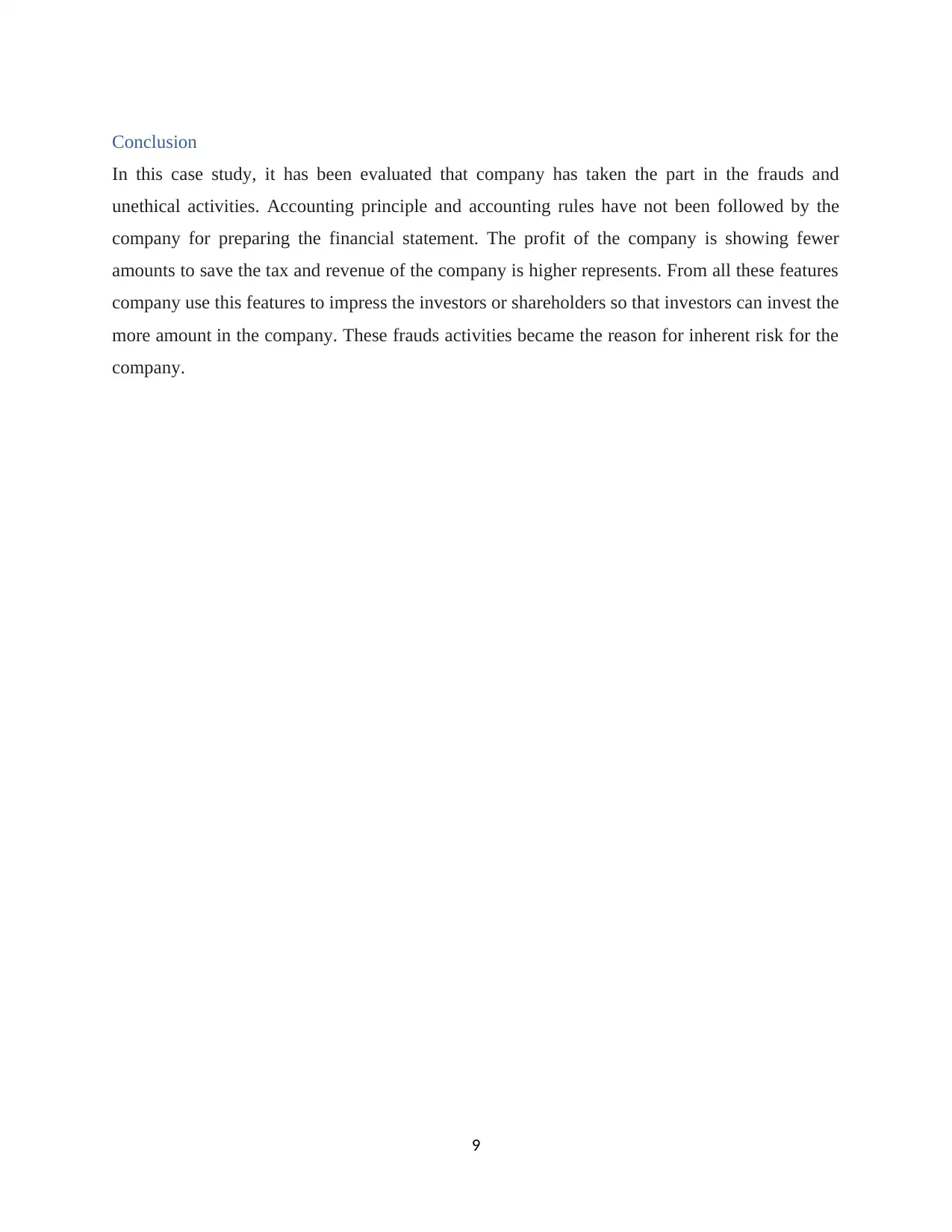
Conclusion
In this case study, it has been evaluated that company has taken the part in the frauds and
unethical activities. Accounting principle and accounting rules have not been followed by the
company for preparing the financial statement. The profit of the company is showing fewer
amounts to save the tax and revenue of the company is higher represents. From all these features
company use this features to impress the investors or shareholders so that investors can invest the
more amount in the company. These frauds activities became the reason for inherent risk for the
company.
9
In this case study, it has been evaluated that company has taken the part in the frauds and
unethical activities. Accounting principle and accounting rules have not been followed by the
company for preparing the financial statement. The profit of the company is showing fewer
amounts to save the tax and revenue of the company is higher represents. From all these features
company use this features to impress the investors or shareholders so that investors can invest the
more amount in the company. These frauds activities became the reason for inherent risk for the
company.
9
⊘ This is a preview!⊘
Do you want full access?
Subscribe today to unlock all pages.

Trusted by 1+ million students worldwide

References
Fazal, . H., 2011. What is Audit risk?. [Online]
Available at: http://pakaccountants.com/what-is-audit-risk/
Israel, D., 2009. Data Analysis in Business Research. s.l. SAGE Publications.
Perler, J. & Howard M. , S. M., 2010. Financial Shenanigans: How to Detect Accounting
Gimmicks & Fraud in Financial Reports, s.l. McGraw Hill Education.
Thibodeau, J. & Freier, . D., 2013. Auditing and Accounting Cases: Investigating Issues of Fraud
and Professional Ethics. s.l.:Wiley.
Bragg, S., 2016. Audit risk model. [Online]
Available at: https://www.accountingtools.com/articles/audit-risk-model.html
[Accessed 21 8 2017].
Bragg, S., 2017. Risk of material misstatement. [Online]
Available at: https://www.accountingtools.com/articles/2017/5/13/risk-of-material-misstatement
[Accessed 24 8 2017].
Dagwell, R., Lambert, C. & Wines, G., 2012. Corporate Accounting in Australia. s.l.:Pearson.
Steve. F., 2012. Business Ethics and Corporate Governance. s.l.:Pearson Education.
Kimmel, P. D. & Weygandt , J. J., 2013. Accounting Principles. s.l.:s.n.
Shaw, K. & Wild , J., 2015. Fundamental Accounting Principles. s.l.:Wiley.
S. S., 2015. Difference Between Accounting and Auditing. [Online]
Available at: http://keydifferences.com/difference-between-accounting-and-auditing.html
[Accessed 23 8 2017].
10
Fazal, . H., 2011. What is Audit risk?. [Online]
Available at: http://pakaccountants.com/what-is-audit-risk/
Israel, D., 2009. Data Analysis in Business Research. s.l. SAGE Publications.
Perler, J. & Howard M. , S. M., 2010. Financial Shenanigans: How to Detect Accounting
Gimmicks & Fraud in Financial Reports, s.l. McGraw Hill Education.
Thibodeau, J. & Freier, . D., 2013. Auditing and Accounting Cases: Investigating Issues of Fraud
and Professional Ethics. s.l.:Wiley.
Bragg, S., 2016. Audit risk model. [Online]
Available at: https://www.accountingtools.com/articles/audit-risk-model.html
[Accessed 21 8 2017].
Bragg, S., 2017. Risk of material misstatement. [Online]
Available at: https://www.accountingtools.com/articles/2017/5/13/risk-of-material-misstatement
[Accessed 24 8 2017].
Dagwell, R., Lambert, C. & Wines, G., 2012. Corporate Accounting in Australia. s.l.:Pearson.
Steve. F., 2012. Business Ethics and Corporate Governance. s.l.:Pearson Education.
Kimmel, P. D. & Weygandt , J. J., 2013. Accounting Principles. s.l.:s.n.
Shaw, K. & Wild , J., 2015. Fundamental Accounting Principles. s.l.:Wiley.
S. S., 2015. Difference Between Accounting and Auditing. [Online]
Available at: http://keydifferences.com/difference-between-accounting-and-auditing.html
[Accessed 23 8 2017].
10
1 out of 10
Related Documents
Your All-in-One AI-Powered Toolkit for Academic Success.
+13062052269
info@desklib.com
Available 24*7 on WhatsApp / Email
![[object Object]](/_next/static/media/star-bottom.7253800d.svg)
Unlock your academic potential
Copyright © 2020–2025 A2Z Services. All Rights Reserved. Developed and managed by ZUCOL.





